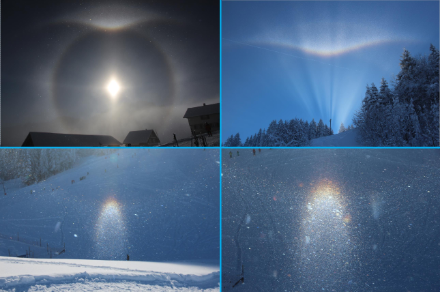Service Navigation
Search
This process usually takes place in the upper troposphere, where ice crystal clouds occur (transparent high clouds known as cirrus or cirrostratus, see clouds) throughout the year in Switzerland. Refraction and reflection of sunlight on the ice crystals can create arcs, circles and fragments in the sky that are either multi-coloured or white.
This phenomenon is called a halo and occurs relatively frequently and – depending on the crystal structures involved – in a wide variety of forms.

Ice crystals, and thus, halos, can form on cold winter days at the fog margins, or even near to the ground if there is a high level of moisture in the air. Since these ice fog halos form very close to the observer, they are particularly impressive.

The names and descriptions of the different halo species can be found at Arbeitskreis Meteore. Extensive information on other optical phenomena in the atmosphere can be found here.